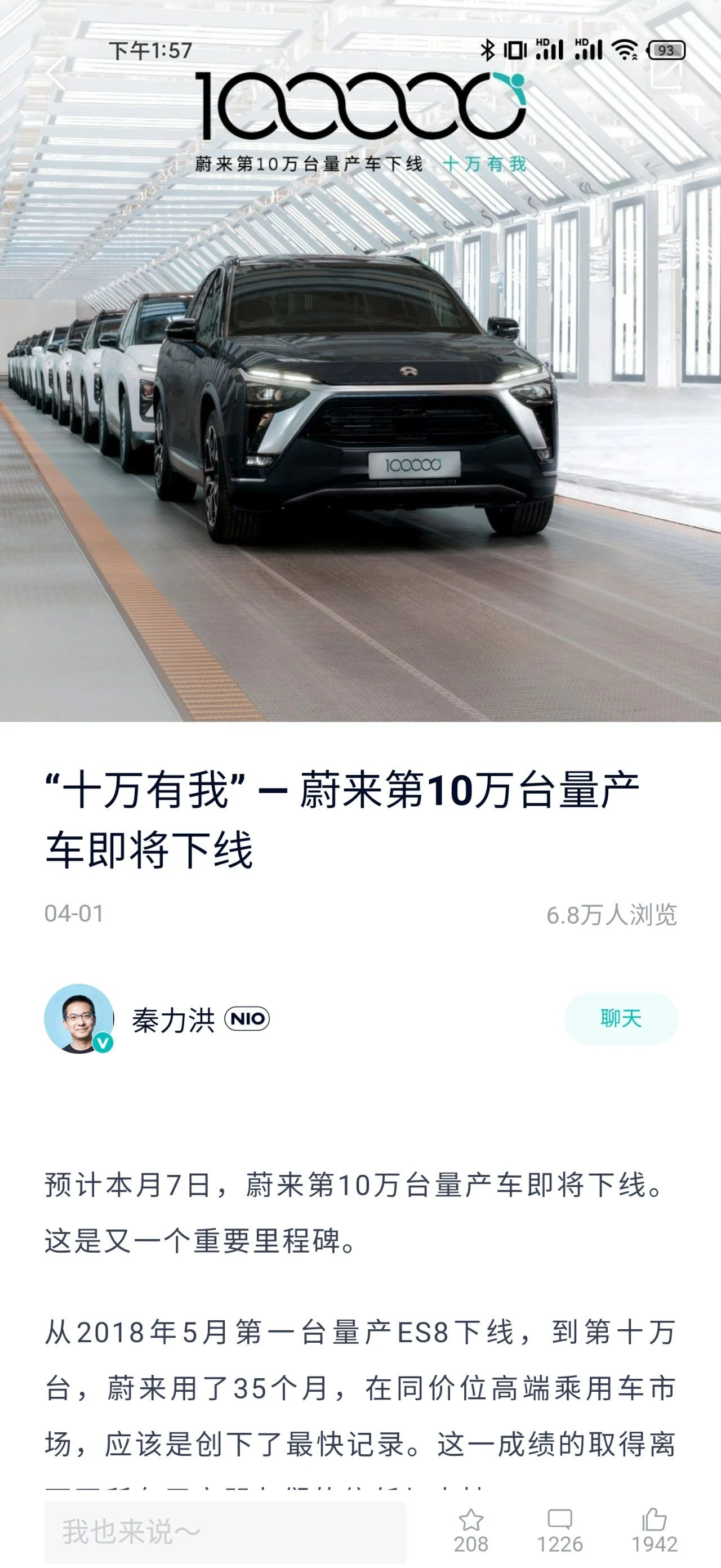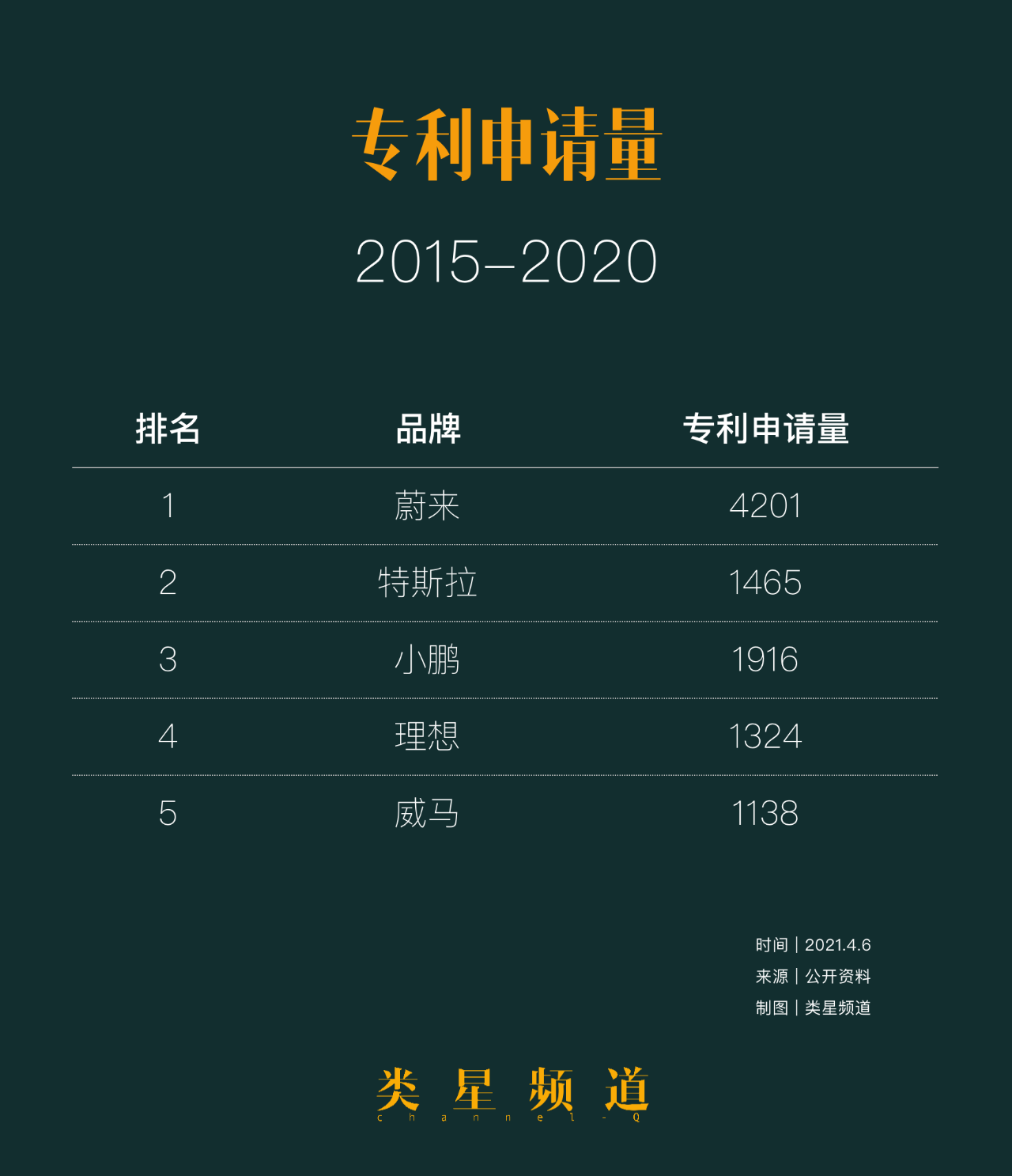Author: Office
Within a week, Mercedes-Benz was preparing for the launch of the EQS smart electric car, General Motors announced their “smart electric” Hummer EV, and Nissan unveiled their smart electric SUV Ariya’s high-altitude testing… The unprecedented excitement in the smart electric car industry means that the phase of “calling out” to educate the market and users has become a thing of the past for new carmakers, and they have finally faced the scrutiny and competition from established car giants.
This is a profound proposition: how strong is the foundation of new carmakers? Besides supporters from the user end, are their R&D, manufacturing, and service systems really strong enough to resist competition from multinational giants?
While we ponder this question, on April 1st, Qin Lihong, NIO’s co-founder and president, personally announced on the NIO app that after delivering the first ES8 35 months ago, NIO’s 100,000th production car will be offline on April 7th.

For the five-year-old NIO and the entire camp of new carmakers in China, this is a significant milestone. However, as mentioned at the beginning, being in the spotlight comes at a cost and NIO will also attract more attention and “firepower”.
With this in mind, we interviewed Liu Xiaochen, NIO’s Senior IP Director of the Legal Department. From the interview, we learned an interesting piece of information: Li Bin’s “user enterprise” concept, which he holds to be of paramount importance, has gained broad recognition from NIO’s users and has brought new opportunities and challenges to the company’s IP work.
Let’s take a look.
No “Smart Car Engineering Major”
Judging by the results, NIO’s IP work is undoubtedly a success. According to official data, as of the end of February 2021, NIO has deployed more than 4,000 patents in China (including mainland China, Hong Kong, and Taiwan), the United States, Europe, Japan, and Korea, among other countries. Of these, more than 1,500 are invention patents, ranking first among new carmakers, far ahead of the second-place.

However, according to Liu Xiaochen, NIO’s IP work didn’t start out so easily.
As the only top new car company in China today that globalized its R&D system, including design, from its inception, NIO’s IP department was required to have project management skills that can span multinational and different time zones.It is not a big problem, as NIO has hired a group of intellectual property talents with 8-9 years of experience in world top 500 companies and profound understanding of intellectual property laws and regulations in North America and Eurasia. Moreover, Mr. Liu has been engaged in relevant work for 19 years. However, the real challenge is that NIO is a hybrid of intelligence and user enterprise, which means that the existing intellectual property talent market cannot meet NIO’s needs. Therefore, NIO has to start from scratch to cultivate talent.
In an interview, Liu Xiaochen expressed the impact of intelligence and user enterprise on his job.
L: Compared with your previous job, what are the unique challenges in NIO’s intellectual property work?
W: There is a major called “Vehicle Engineering” in universities, but there is no “Intelligent Vehicle Engineering” major that covers all the technologies required for an intelligent vehicle, such as user service, design, artificial intelligence, and autonomous driving.
This requires our team to have a fast learning and iteration ability. When we recruit people, the two most critical requirements are:
- Have worked for a world top 500 or well-known law firm for at least 8-9 years.
- Have the ability and willingness to learn and iterate proactively.
Actually, the latter is more important, which was also painful for me when I came here. In fact, no one has so many interdisciplinary backgrounds today, which requires us (the team) to participate in a lot of project meetings and get involved in the early development of the product to learn and understand it.
From the statistical results, NIO’s patent portfolio perfectly reflects its enterprise attributes of intelligence and user concept. In addition to “traditional” vehicle patents such as whole vehicle engineering, manufacturing and quality, and vehicle design, NIO has also applied for a large number of patents for its unique battery swapping technology (power management), autonomous driving and digital cockpit, user development and service operation, and user digital products.
Simple calculations show that these exclusive NIO patents account for as much as 38% of NIO’s patent portfolio, with nearly 1600 patents in areas that other car manufacturers have not and will not be involved in, representing NIO’s most differentiated and real competitiveness.
“On the corresponding layout has been done, but cannot be disclosed.”
On March 2, at the NIO 2020 Q4 and full-year earnings conference, Li Bin revealed that the proportion of BaaS (battery leasing service) in newly added orders in February reached 55%. This is a turning point where users who prefer leasing batteries officially exceeded those who prefer to buy batteries.
As NIO’s Vice President of Energy, Shen Fei said, the physical basis for all of this is battery swapping.Until now, “battery swapping” has become one of the most important tags for NIO. It has gone through the stages of Better Place, Tesla, BAIC, and NIO has always been in close cooperation. However, other Chinese automakers such as SAIC, Geely, BAIC are also joining in. So, what has NIO done in terms of patent deployment for battery swapping?
L: Which team developed the Bayobolt locking mechanism for the battery swapping station? How did the NIO patent team follow up on the patent layout for this project?
(*Bayobolt is a unique locking mechanism in NIO’s battery swapping system. While ensuring the structural strength of supporting the battery, it can withstand repeated dismantling and installation for thousands of times. It is one of the most important components for NIO’s battery rental service.)
W: Bayobolt was jointly developed by the vehicle and energy departments because it involves the interaction between the station and the car. Our battery swapping system needs to maintain its health over the entire vehicle lifecycle, including various working conditions, such as rainy weather, which requires the design of cleaning to ensure quick calibration and fast locking and unlocking between station and vehicle.
In fact, we have applied for several dozen patents for Bayobolt, involving different solutions. During the testing stage, there is no best or second-best solution. Engineers will test them all, and the best solution will be selected for mass production. However, we must protect all the solutions we have developed under patent protection.
Therefore, you will find that other battery swapping solutions on the market use completely different structures.
On January 9th, at the NIO Day event, NIO officially released the second-generation battery swapping station, which can accommodate up to 13 batteries per station and complete up to 312 swaps per day. It also supports vehicle automatic parking and swapping, without the need for personnel presence. This upgrade reduces operating costs while improving the user experience.
In the interview, Liu mentioned that NIO did comprehensive patent protection for the second-generation station, but the specific details “cannot be disclosed.”
How did NIO build a patent wall of over 4,000 patents?
In 2015, when Liu joined NIO, the company had already launched its global design and research and development, with over 14 billion RMB invested in R&D, which continued to produce a steady stream of intellectual property.
L: What is the specific process for NIO’s patent application?
W: Our team is divided into two directions. One is the patent exploration team, which intervenes very early, including the project initiation meeting, to explore related patents throughout the entire product development.
The other direction is the back-end team. They conduct searches and communicate with the engineering team if any problems are found, and then write the proposals for the patent application.
From the overall work perspective, we have a process. The first thing I did when I came in 2015 was to include patent applications in the entire vehicle development process.All small projects need to establish a patent form for check, through the management of the process to ensure that all project nodes are covered in engineering.
What is “process management”? According to the introduction, NIO has designed a patent reward system to inspire engineers to apply for patents at key project nodes and protect the company’s intellectual property.
At the same time, in order to further improve the efficiency of patent application and avoid wasting resources, engineers are required to submit patent applications for approval at two levels: department directors and vice presidents, to ensure that the applied patents are original and have high application prospects.
From this point of view, NIO has already reached a relatively mature stage in the standardized protection of research and development results. This is consistent with the beginning of the article where NIO was the first to break through the production scale of 100,000 vehicles in the new car camp, and it also explains why NIO was able to achieve the speed of 100,000 vehicles in just 35 months.
From the patent wars between Apple and Samsung, to the legal disputes between LG Chemical and SL Innovation, as Zhang Ping, Vice Dean of the School of Intellectual Property at Peking University, said, in market competition, if you want to enter international trade, if you do not have intellectual property, you will definitely encounter obstacles from the other side. The intellectual property system is a protection for enterprise research and development results, and is also a powerful weapon in market competition.
Facing the traditional luxury brands is a new brand that values both service and research and development, and even more importantly research and development protection. NIO is not an easy opponent.
This article is a translation by ChatGPT of a Chinese report from 42HOW. If you have any questions about it, please email bd@42how.com.